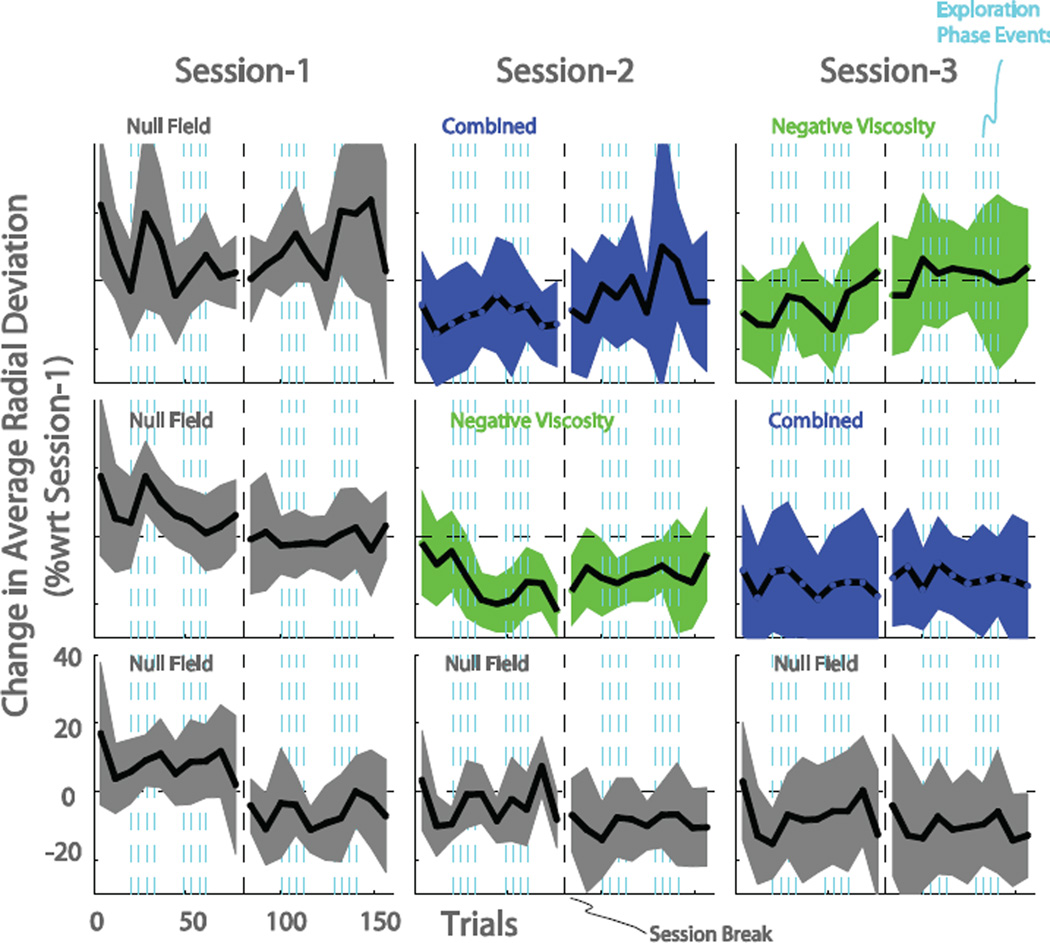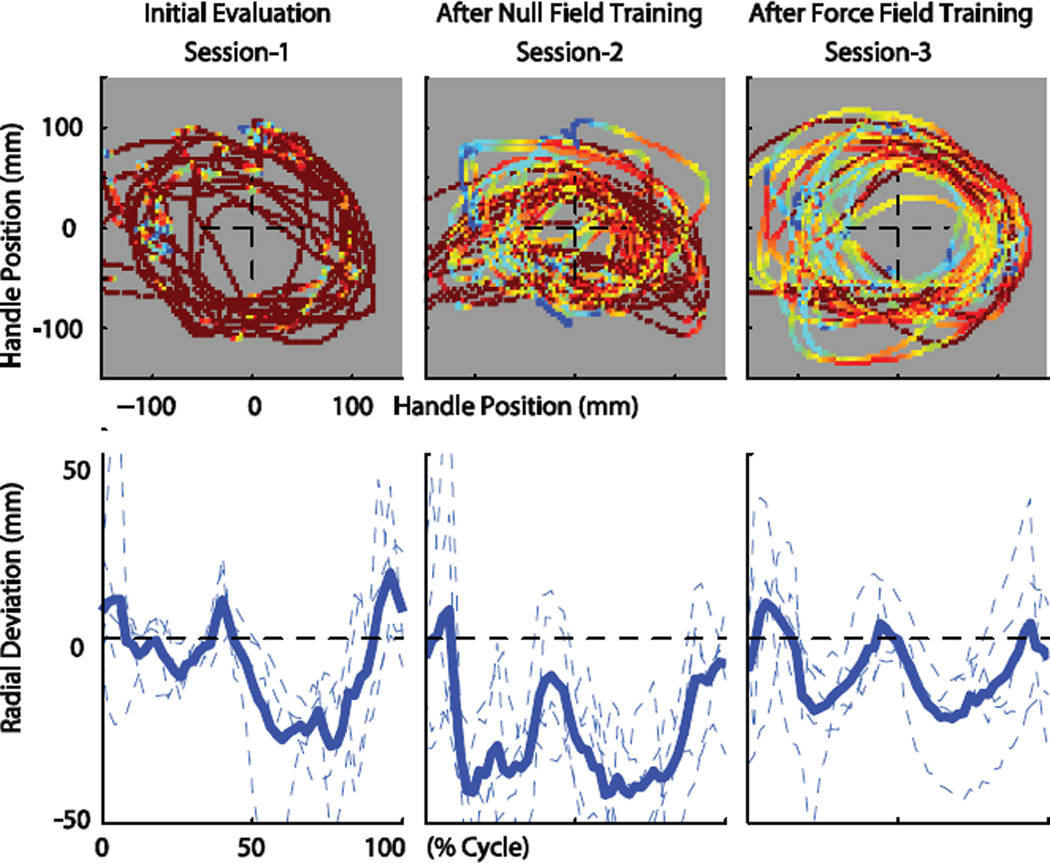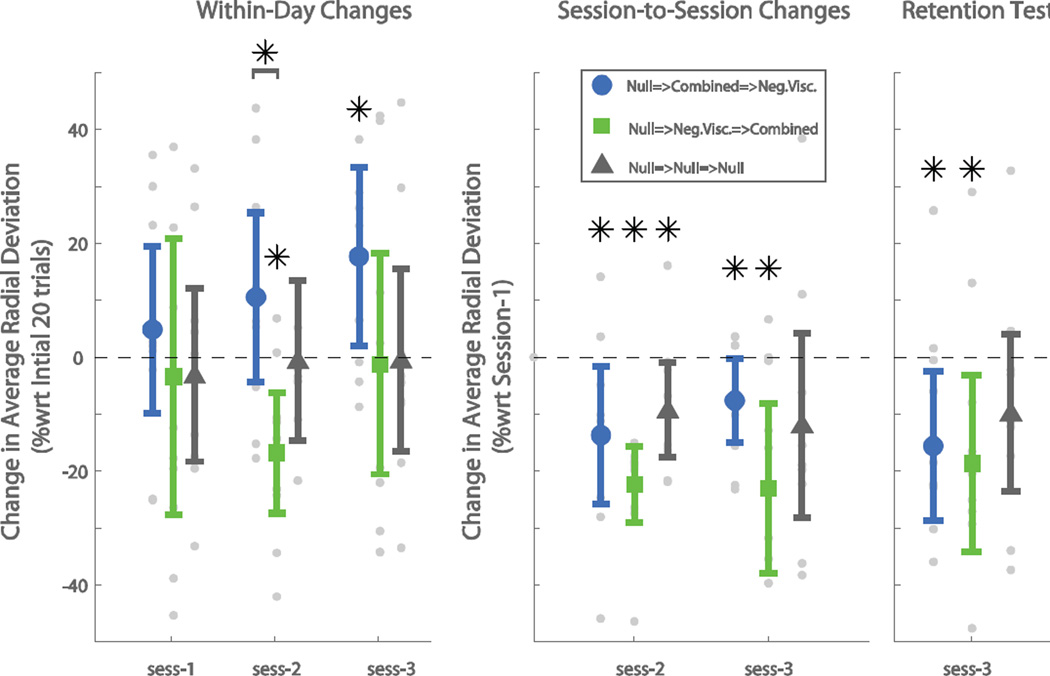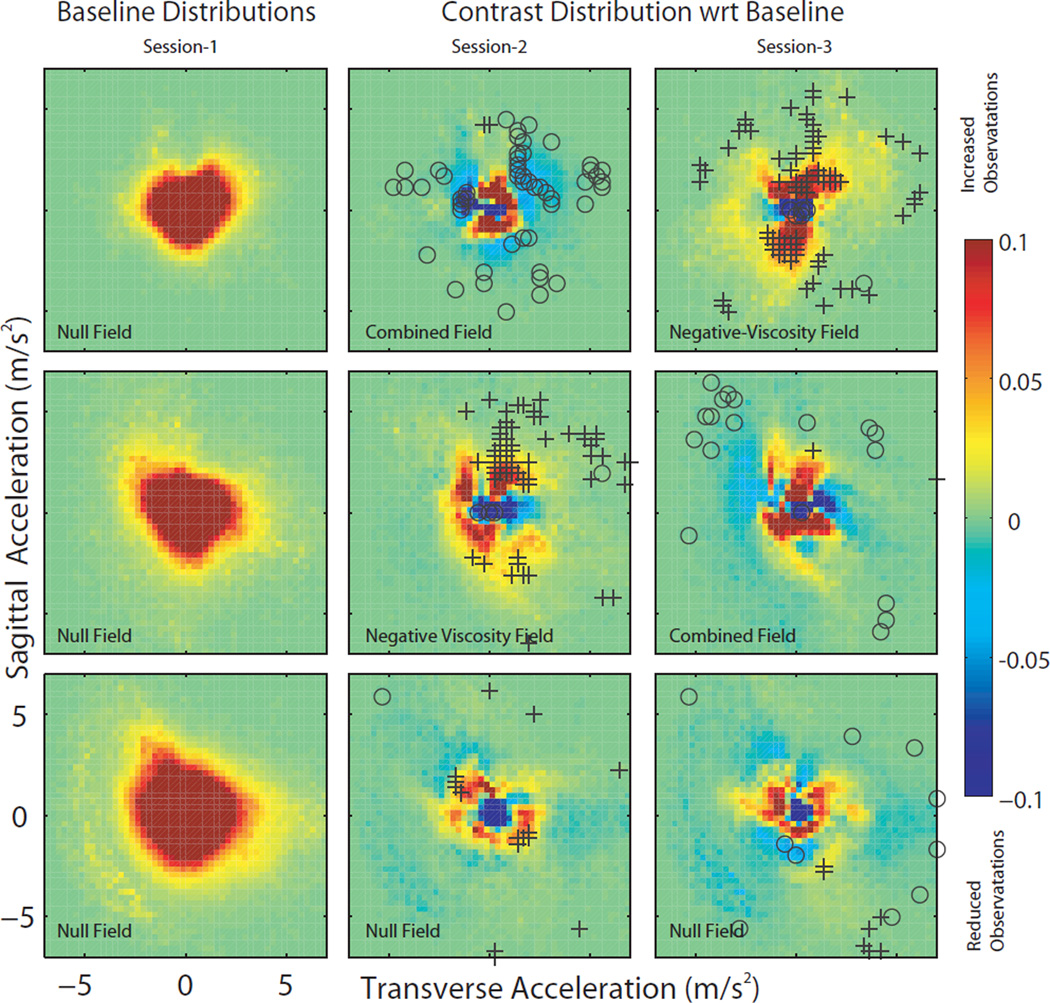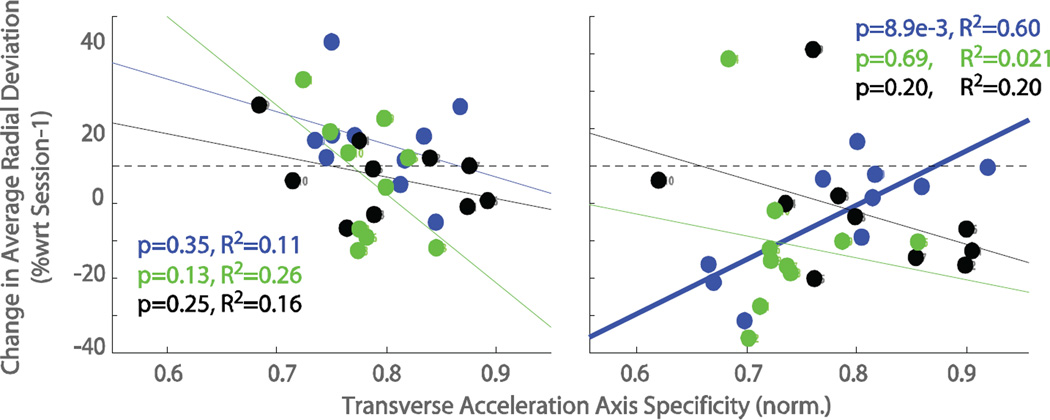Abstract
With stroke survivors (n=30) as the test population, we investigated how upper extremity training with negative viscosity affects coordination in unassisted conditions. Using a planar force-feedback device, subjects performed exploratory movements within an environment that simulated 1) negative viscosity added to elbow and shoulder joints 2) augmented inertia to the upper and lower arm combined with negative viscosity, or 3) a null force field (control). After training, we evaluated each subject’s ability to perform circular movements in the null field. Negative viscosity training resulted in greater within-day reductions in error compared with the combined field training. Negative viscosity promoted greater distributions of accelerations during free exploration, especially in the sagittal axis, while combined field training diminished overall activity. Both force field training groups exhibited next day retention, while this was not observed for the control group. The improvement in performance suggests that greater range of kinematic experiences contribute to learning, even despite novel force field environments. These findings provide support for the use of movement amplifying environments for upper extremity rehabilitation, allowing greater access to training while maintaining user engagement.
Keywords: robotic rehabilitation, upper extremity, skill transfer
I. Introduction
Recent findings in robot-assisted therapy have revealed a critical lesson: while robotic devices can facilitate movement, they must also engage the learning process. To this end, our previous work [1] has shown that robot-applied forces can support these goals simultaneously by amplifying the intended actions of the learner. The critical finding from this work was that improvements in performance persisted even when forces were removed. A major advantage to such movement amplifying forces is allowing access to coordination training even when weakness limits voluntary motion. In addition, movement amplification increases awareness of errors—information critical for driving adaptation. This study explores how robotic interfaces could provide the necessary assistance while simultaneously promoting engagement by the learner. We consider two key features to facilitate this process: destabilizing forces that amplify intended actions, and motor exploration, or user-directed movements, to serve as training.
While the challenges to stroke rehabilitation are great, robotic interfaces provide opportunities to stimulate motor learning in ways not possible with traditional exercise techniques. Researchers have explored the use of robotic interfaces for increasing access to exercise and to elicit changes in motor planning. Assistive loading provided from a robot enables increases range of motion with decreased physical effort [2–3]. Stroke survivors training with custom force fields can learn to straighten movement trajectories [4]. While such devices facilitate access to exercise, recent investigations have shown that patients fail to improve when participating in passive movement [5–7]. Our motivation for using destabilizing forces is to find a way to increase accessibility to movement training without removing the learner’s participation.
In an effort to promote general coordination skill, we considered a training paradigm in which the learner is allowed to direct their own movement. While goal-directed movement focuses on performance, we speculate that exploratory movement facilitates preparation for future movements. Such training inherently lacks repetition, but nonetheless features relevant force and motion relationships. In terms rehabilitation, training on a variety of tasks provides better improvement in overall function than repetitions of the same task [8–9]. We consider how a robotic interface can encourage changes in self-directed movement, and hence influence success in motor planning. One advantage to combining robotic intervention with exploration is that it does not require specification of any task. Consequently, patients can direct their own learning, reinforcing learning through a greater sense agency. Such a training paradigm serves as an excellent measure of learning generalization, since the structured evaluations after training (for example, following a circular path) necessarily differs from the exploratory practice.
With stroke survivors as a test population, we investigated how training with force fields that exaggerate dynamics of the arm influences generalization to performance without external forces. Subjects trained with several periods of free exploration, alternating with phases of performance evaluation. To serve as an evaluation of learning, we asked tested the ability of these subjects to perform accurate circular movements. We examined three forms of robotic interaction during motor exploration training: using 1) negative viscosity (velocity-dependent destabilizing forces), 2) inertial combined with negative-viscosity and 3) a control with no external forces. We hypothesized that training with negative viscosity would expand the forms of movements available during training and subsequently lead to improved coordination of the arm even in the absence of external forces.
II. Methods
A. Humans Subjects
In this study 30 stroke survivors were randomly assigned to one of three training groups. Each subject provided informed consent in accordance with Northwestern University Institutional Review Board. Individuals were paid for their participation. Subjects performed the task with their affected arm (16 left-affected, 14 right-affected).
B. Apparatus and Implementation of Force Fields
We asked subjects to control the movement of a planar force-feedback device (Fig. 1) as described in our previous work [10]. To focus training on the coordination of the forearm and upper arm, subjects operated the device through a wrist brace. The brace was connected to a revolute joint, such that endpoint forces could be presented to the arm at the wrist. For some conditions, we programmed the device to present forces that augmented the mechanical behavior of the arm (as shown in Fig. 1), in terms of increased limb inertia of the upper arm and forearm, and/or decreased viscosity of the shoulder and elbow joints. We matched the lengths of the upper arm and forearm (L1 and L2) of the virtual system to those for each subject, so that virtual and real limb motions could be as close as possible.
Fig. 1.
(A) The robotic interface interfaced to the arm about a free pivot at the wrist. Subjects were allowed to freely interact with each load in a “motor exploration” stage. Following exploration, subjects made counter-clockwise circular movements during task performance trials at random starting locations of a 0.1 m radius circular track. (B) The virtual arm augmented the existing dynamics of the human arm with negative viscosity in the elbow and shoulder and/or positive inertia to the upper and forearm, delivering end-point forces to the arm at the wrist.
With absolute angles of the upper arm and forearm defined as θ1 and θ2, endpoint forces Fx(t) and Fy(t) were presented according to:
| (1) |
For this study, we presented the same levels of augmented inertia (m1=1.5 kg, I1=I2=1.0 kg-m2) and/negative viscosity for all subjects (b1=b2=−0.5 N-m-s/rad) during the training portions of the experiment. These levels were chosen so that the peak forces were less than 15 N for the expected typical movement.
Using an overhead projector mounted on the ceiling, real-time feedback of the handle position, visual reference cues, and experiment instructions were presented on a horizontal surface overlaying the planar workspace of the arm (see Fig. 1). In addition, the real-time animation included two segments approximating the motion of the forearm and upper arm. Visual reference cues included a circular reference track (shown in white, 0.1 m radius), which acted as a target path for performance evaluation, or a larger rectangular region, indicating the bounds of movement for the motor exploration portions of the experiment.
Using MATLAB XPC-Target (Natick, MA) a computer performed real-time differentiation and filtering (low-pass cutoff at 11 Hz) of the robot encoder data. Using measurements of the handle endpoint position, the computer produced estimates of the subject’s angular velocity and accelerations of the arm. The resulting force fields exhibited delays of less than 40 ms. Data were collected at 100 Hz. The basic rate of dynamics simulation was 2 kHz.
C. Protocol
The experiment design featured training and evaluation phases with markedly different motor activities. This separation allowed for a test of generalization and also provided subjects a contextual cue about changes in the loading from the robot. During motor exploration, we instructed subjects to move the handle at their own discretion using a variety of directions, speeds, and positions within the rectangular workspace (0.2 × 0.6m). We explained that each exploration phase should serve as preparation for the next evaluation phase. The computer signaled the user to halt motor exploration after 25 meters of handle endpoint total travel.
For the performance evaluation phases, subjects were instructed to move the robotic interface quickly in four complete counter-clockwise revolutions around a target circular track. After each trial, feedback was also provided as to whether average movement speed was too fast or slow (0.75 cycles per second). Subjects were told to achieve accurate and smooth performance as much as possible. Four starting locations were indicated on the track. No further instruction was provided about strategy for the evaluation. For the performance evaluations, the robot presented a null field.
We presented subjects with an experiment schedule that facilitated practice for switching between training and evaluation conditions. Each session included several alternating training (16) and evaluation trials (160). The intervals between training phases varied between 4 or 20 trials, as is indicated in the performance plot in Fig. 3. We included different intervals of performance evaluation to test possible differences in retention. The first set of evaluation trials (20) at the beginning of the session served as the baseline. Each session included two 1-hour blocks, with a 15 minute intervening break.
Fig. 3.
The average radial deviation for three groups exhibited reductions in the first session over the course of trials (8 trial moving average shown), as well as disruptions following exposure to periods free exploration training (blue dashed). Groups (by rows) differed in the sequence of training fields for each session (columns): null-field, combined-load, negative-viscosity (NCV), null-field, negative-viscosity, combined-load (NVC), null-field for each session (NNN). Note that all evaluation trials are in null-field conditions.
Subjects performed three sessions. The first session was a baseline condition, in which subjects trained and performed evaluation trials without forces (null field). The second and third sessions included either augmented negative joint viscosity or positive limb inertia and negative joint viscosity during training. Experiment groups differed in f the sequence of training conditions on the second and third sessions. We will refer to these groups as NVC (Null-Field, Negative-Viscosity, Combined) and NCV (Null-Field, Combined, Negative-Viscosity), and the control group NNN (Null-Field each session), according to their sequence of training sessions.
D. Data Analysis
To characterize differences in learning, we analyzed changes in performance evaluations for each group. As a performance metric, we examined the average “radial deviation” or the magnitude of error between the radius of the target circular path and the actual movement during evaluation trials (See Fig. 2). To determine the immediate impact of training, we considered changes within each session for each training condition (initial and final 20 trials). Then to determine whether the influence of training persisted, we also calculated the mean performance changes from session to session (all trials after initial evaluation). We also examined success in retention by computing the change in evaluation (20 trials) in the session following exposure to force field training. We hypothesized that the training force fields would promote greater improvements in learning compared to the control condition. Using the metric described above, we performed paired t-tests (two-tail) to assess performance changes. We compared performance between subjects groups, using an ANOVA with two-way interactions between three experiment factors: subject group (NCV, NVC, NNN), session (1–3), trial block (1–2). To correct for multiple pair-wise group comparisons, Bonferroni corrections were applied to computed p-values. The threshold level of significance for statistical tests was set at α=0.05.
Fig. 2.
Trajectories of the initial evaluation (4 sample trials) show typical improvement over the course of three sessions (typical NVC subject. Color gradation (upper plots) indicates variations between highest to lowest speeds observed (red to blue). Mean radial deviation (blue line, lower plots) indicate reduction of systematic error.
III. Results
Within-day changes
Analysis of within-day changes in performance (initial and final 20 evaluation trials) revealed the most dramatic reductions in error from training with negative viscosity (See Fig 4, left). In session-1, subjects exhibited trends of gradual improvement (null field training), that however did not achieve significance. In contrast, in session-2 subjects training with negative viscosity exhibited a mean reduction of 1.5 mm (CI: 0.2, 2.9) in radial deviation (mean change 16.8%; CI: 27.5, 6.21, p=5.90e-3, paired t-test). In terms of between-group comparisons, for session 2 training with negative viscosity resulted in greater reduction in error compared with the combined condition (mean difference 27.4%, CI: 11.5, 46.7; p=8.3e-3, t-test). In session-3, the NCV group (training with negative viscosity) exhibited a 0.9 mm (CI:−0.1, 1.9) increase in radial deviation within the session (mean change 17.7%; CI: 2.0, 33.3, p=3.12e-2, paired t-test), indicating possible fatigue effects or interference from prior learning (training with combined).
Fig. 4.
(A) In within-day changes for session-2 (initial and final 20 trials, left panel), only training with negative viscosity (NVC group) resulted in reduced radial deviation (mean change 16.8%; CI:27.5, 6.21, p=5.90e-3, paired t-test). Training with negative viscosity resulted in greater reduction in error compared with the combined condition (mean difference 27.4%, CI: 11.5, 46.7; p=8.3e-3, t-test). (B) Session to session, (center), decreased radial deviation was observed for combined (session 2: mean 13.7, CI: 1.7, 25.7% change, p=2.95e-2, paired t-test) and negative viscosity training (session 2: 22.4%; CI: 15.7, 19.1, p=3.44e-5, paired t-test). (C) Following the second session, both test groups exhibited retention of improvements (right), for combined training (15.6%; CI:−2.54, 28.7, p=2.44e-2, paired t-test) and negative viscosity training (18.7%; CI: 3.1,−34.2, p=2.37e-2, paired t-test).
Session-to-session changes
While the immediate impact of training can be seen with within-session changes, we also found improvements persisting to successive sessions. In terms of changes between sessions (See Fig 4, center), training with destabilizing forces promoted significant improvements that persisted into last session. In session 2, combined training resulted in an average of 1.1 mm (CI: 0.1, 2.1) decrease in radial error (mean 13.7, CI: 1.7, 25.7% change relative to session 1, p=2.95e-2, paired t-test). Similarly, in session 2, negative viscosity training resulted in an average of 1.9 mm (CI: 1.0, 2.7) decrease in radial error (22.4%; CI: 15.7, 19.1 change relative session 1, p=3.44e–5, paired t-test). Results remained significant only for each of the test groups (NCV and NVC). In terms of between-group comparisons, for session 2 training with negative viscosity resulted in greater reduction in error compared with the control condition (mean difference 13.2%, CI: 23.1, 3.2; p=1.23e–2, t-test).
Short term retention
We examined the evaluation trials at the beginning of each session (See Fig 4, right), and found that only test groups retained performance improvements when evaluated in the session after their exposure to the force fields. Combined training (NCV group) resulted a mean of 1.1 mm (CI: 0, 2.16) reduction in radial deviation (15.6%; CI: 2.54, 28.7 change relative session 1, p=2.44e-2, paired t-test). Negative viscosity (NVC group) training resulted a mean of (−1.4 mm CI: 0.2, 3.0) reduction in radial deviation (18.7%; CI: 3.1,−34.2 change relative to session 1, p=2.37e-2, paired t-test). The retention by the control group was not significant, with only a 0.7 mm (CI:−0.4, 1.8) reduction (9.8% mean reduction; CI:−4.1, 23.6).
Direct influence of force fields
We performed histograms of the handle acceleration during motor exploration and found that negative viscosity exhibited the strongest impact on the expanding the distribution of movement. As shown in Fig. 5, training with negative viscosity resulted in increased observations for larger accelerations especially in the sagittal axis of motion. This result was true for both NCV and NVC groups. In contrast the combined training actually exhibited a trend of decreased activity for large accelerations.
Fig. 5.
Histograms of the handle acceleration in plane (group averaged, 50 point bins) show how training force fields (center and right) differ from baseline distributions (left). Negative viscosity training exhibits trends of increasing activity in the sagittal axis, while combined-load tends to decrease large accelerations overall (+/o signs indicate increase/decrease where 95% CI intervals exclude zero). These findings suggest that negative viscosity facilitates greater elbow flexion-extension activity during motor exploration training.
Correlation Analysis
In addition to analyzing performance during evaluations, we investigated whether differences in learning could be predicted from the exploration behavior. Our analysis suggests that training that is over-practice in the transverse axis produced a detrimental effect on learning. Focusing our analysis on session-2, combined training resulted in a significant correlation between exploration behavior and subsequent performance (See Fig. 6). We observed that greater specificity in the transverse axis of motion negatively correlated with performance improvement (p=8.9e-3, R2=0.6). Complementary results were found along the sagittal axis, in that greater specificity exhibited a trend of greater performance improvement. Similar analyses did not reveal significant correlations for the other groups for session 2, nor for any group in session 1. These findings suggest that neglecting practice with elbow flexion-extension can negatively impact skill transfer to the null-field condition.
Fig 6.
Combined training in session-2 exhibited significant correlation (p=8.9e-3, R2=0.6) between the exploration behavior (specificity of along the transverse axis) versus subsequent performance (average radial deviation). We defined acceleration specificity as the 95th percentile of data observed along a given axis, divided by that of the scalar acceleration. These results suggest that over-practice in the transverse axis (shoulder dominated motion) prohibits optimal learning.
The above patterns could indicate performance variations due to learning, or could have plausibly reflected individual differences. To help clarify this issue, we performed additional correlation analyses between exploration behavior metrics and performance evaluations prior to motor exploration training. Interestingly, regression analyses indicated non-significant levels for each group (NCV: p=0.77, R2=0.011; NVC: p=0.51, R2=0.056; NNN: p=0.34, R2=0.12).
IV. Discussion
With stroke survivors as the test population, we examined two different forms of destabilizing force fields as candidates for training dynamic arm coordination. We found the most dramatic within day improvement for negative viscosity training, while both combined and negative viscosity training exhibited lasting benefits by the final short term retention test. A correlation analysis between exploration behavior and subsequent performance indicated that the particular distribution of acceleration states experienced during training impacts the quality of learning.
Our motivations for the study of destabilizing forces for training were to facilitate movement while maintaining active involvement by the leaner. Robot-applied forces can certainly expand human capabilities by amplifying user intentions [11–12]. In terms of assisting rehabilitation, recent work in robot-assisted rehabilitation have achieved success by assisting the patient as needed [13], by applying EMG-dependent forces [14], by basing assistance on performance [15], and by gradually reducing the level of assistance according to an adaptive algorithm [16]. These approaches, however, have focused on applying assistive action within the task itself. A critical goal of our experiment design is to develop robot-assisted training that can both facilitate training and aid the transition to unassisted conditions.
The findings of this study suggest that successful transfer is possible between destabilizing forces and a null field. It was plausible that such forces present during training could have resulted in learning that was inappropriate for the evaluation conditions, which lacked external forces. Evidence suggests that manual training with one type of sensorimotor mapping can interfere with learning in subsequent conditions [17–20]. While external forces must introduce a different sensorimotor environment, we designed the training environment to exhibit dynamic behavior that maintains features of the unaided arm. We presented force interactions that were in the same joint coordinates system as the arm, potentially easing the transition from training to evaluation conditions.
Despite the presence of external forces, the overlap between the training and evaluation conditions was sufficient to allow successful transfer of skills. The human motor system can evidently integrate visuo-motor and force adaptation to perform successfully in combined conditions [21–22]. Hence the motor system might take into account the dynamic similarities between environments to aid the process of skill transfer. Interestingly, we did observe increased error that occurred upon switching between motor exploration and task performance, when no training forces were presented (session-1). These results suggest that experiencing intermittent exploration may at least initially cause a disruption to the process of iterative error-correction. We also observed increased error for the NCV group on session-3, which might indicate a competition between strategies for the different presented force fields.
Practice in neglected patterns of movement could have also benefitted the motor system through use-dependent learning [23]. Just as mechanical characteristics of the arm and wielded objects influence preferred movements [24–26], the available movement patterns of free exploration naturally differ with external loading. Researchers found that infants, in learning to express reaching, exhibited exploratory actions subject to intrinsic dynamics of the arm [27–28]. In terms of rehabilitation, force fields have the potential to break stereotypic patterns of movement by changing these intrinsic dynamics. Our results suggest that motor exploration training for stroke survivors can expand the range of movements, particularly in the direction of elbow flexion-extension.
Another important perspective is that exploratory movement, expanded with destabilizing forces, could serve to improve formation of neural representations. The motor system can generalize learned strategies to various movement trajectories spanning similar positions and velocities [29]. Rather than rote memorization of motor commands, the nervous system appears to learn associations between forces and movement states[30]. From a systems modeling perspective, broader excitation of movement states informs more accurate system identification [31]. In terms motor recovery, training on a variety of tasks provides better improvement in overall function than repetitions of the same task [8–9]. Allowing free movement presumably would provide the richest experiences of these dynamic relationships.
Acknowledgments
This work was supported by NINDS grant NS357673 and NINDS grant NS053606.
Contributor Information
Felix C. Huang, Dept. of Physical Medicine & Rehabilitation, Northwestern University, Chicago, IL USA
James L. Patton, Dept. of BioEngineering, University of Illinois at Chicago, Chicago, IL USA
References
- 1.Huang FC, et al. Manual skill generalization enhanced by negative viscosity. J Neurophysiol. 2010 Oct;104:2008–2019. doi: 10.1152/jn.00433.2009. [DOI] [PMC free article] [PubMed] [Google Scholar]
- 2.Kahn LE, et al. Robot-assisted movement training for the stroke-impaired arm: Does it matter what the robot does? J Rehabil Res Dev. 2006 Aug-Sep;43:619–630. doi: 10.1682/jrrd.2005.03.0056. [DOI] [PubMed] [Google Scholar]
- 3.Johnson MJ, et al. Experimental results using force-feedback cueing in robot-assisted stroke therapy. IEEE Trans Neural Syst Rehabil Eng. 2005 Sep;13:335–348. doi: 10.1109/TNSRE.2005.850428. [DOI] [PubMed] [Google Scholar]
- 4.Patton JL, et al. Evaluation of robotic training forces that either enhance or reduce error in chronic hemiparetic stroke survivors. Exp Brain Res. 2006 Jan;168:368–383. doi: 10.1007/s00221-005-0097-8. [DOI] [PubMed] [Google Scholar]
- 5.Hornby TG, et al. Manually-assisted versus robotic-assisted body weight-supported treadmill training in spinal cord injury: what is the role of each? PM R. 2010 Mar;2:214–221. doi: 10.1016/j.pmrj.2010.02.013. [DOI] [PubMed] [Google Scholar]
- 6.Marchal-Crespo L, Reinkensmeyer DJ. Review of control strategies for robotic movement training after neurologic injury. J Neuroeng Rehabil. 2009;6:20. doi: 10.1186/1743-0003-6-20. [DOI] [PMC free article] [PubMed] [Google Scholar]
- 7.Lotze M, et al. Motor learning elicited by voluntary drive. Brain. 2003 Apr;126:866–872. doi: 10.1093/brain/awg079. [DOI] [PubMed] [Google Scholar]
- 8.Hanlon RE. Motor learning following unilateral stroke. Arch Phys Med Rehabil. 1996 Aug;77:811–815. doi: 10.1016/s0003-9993(96)90262-2. [DOI] [PubMed] [Google Scholar]
- 9.Jarus T, Gutman T. Effects of cognitive processes and task complexity on acquisition, retention, and transfer of motor skills. Can J Occup Ther. 2001 Dec;68:280–289. doi: 10.1177/000841740106800504. [DOI] [PubMed] [Google Scholar]
- 10.Patton JL, Mussa-Ivaldi FA. Robot-assisted adaptive training: custom force fields for teaching movement patterns. IEEE Trans Biomed Eng. 2004 Apr;51:636–646. doi: 10.1109/TBME.2003.821035. [DOI] [PubMed] [Google Scholar]
- 11.Kazerooni H. The human power amplifier technology at the University of California, Berkeley. Robotics and Autonomous Systems. 1996;19:179–187. doi: 10.1016/s0921-8890(96)00045-0. [DOI] [PubMed] [Google Scholar]
- 12.Aguirre-Ollinger G, et al. Active-Impedance Control of a Lower-Limb Assistive Exoskeleton; Rehabilitation Robotics, 2007. ICORR 2007. IEEE 10th International Conference on; 2007. pp. 188–195. [Google Scholar]
- 13.Emken JL, Reinkensmeyer DJ. Robot-enhanced motor learning: accelerating internal model formation during locomotion by transient dynamic amplification. IEEE Trans Neural Syst Rehabil Eng. 2005 Mar;13:33–39. doi: 10.1109/TNSRE.2004.843173. [DOI] [PubMed] [Google Scholar]
- 14.Dipietro L, et al. Customized interactive robotic treatment for stroke: EMG-triggered therapy. IEEE Trans Neural Syst Rehabil Eng. 2005 Sep;13:325–334. doi: 10.1109/TNSRE.2005.850423. [DOI] [PMC free article] [PubMed] [Google Scholar]
- 15.Krebs HI, et al. Rehabilitation Robotics: Performance-Based Progressive Robot-Assisted Therapy. Autonomous Robots. 2003;15:7–20. [Google Scholar]
- 16.Kahn LE, et al. Adaptive assistance for guided force training in chronic stroke. Conf Proc IEEE Eng Med Biol Soc. 2004;4:2722–2725. doi: 10.1109/IEMBS.2004.1403780. [DOI] [PubMed] [Google Scholar]
- 17.Krakauer JW, et al. Generalization of motor learning depends on the history of prior action. PLoS Biol. 2006 Oct;4:e316. doi: 10.1371/journal.pbio.0040316. [DOI] [PMC free article] [PubMed] [Google Scholar]
- 18.Tong C, et al. Kinematics and dynamics are not represented independently in motor working memory: evidence from an interference study. J Neurosci. 2002 Feb 1;22:1108–1113. doi: 10.1523/JNEUROSCI.22-03-01108.2002. [DOI] [PMC free article] [PubMed] [Google Scholar]
- 19.Hinder MR, et al. The interference effects of non-rotated versus counter-rotated trials in visuomotor adaptation. Exp Brain Res. 2007 Jul;180:629–640. doi: 10.1007/s00221-007-0888-1. [DOI] [PubMed] [Google Scholar]
- 20.Salimi I, et al. Specificity of internal representations underlying grasping. J Neurophysiol. 2000 Nov;84:2390–2397. doi: 10.1152/jn.2000.84.5.2390. [DOI] [PubMed] [Google Scholar]
- 21.Ghahramani Z, Wolpert DM. Modular decomposition in visuomotor learning. Nature. 1997 Mar 27;386:392–395. doi: 10.1038/386392a0. [DOI] [PubMed] [Google Scholar]
- 22.Davidson PR, Wolpert DM. Internal models underlying grasp can be additively combined. Exp Brain Res. 2004 Apr;155:334–340. doi: 10.1007/s00221-003-1730-z. [DOI] [PubMed] [Google Scholar]
- 23.Diedrichsen J, et al. Use-Dependent and Error-Based Learning of Motor Behaviors. J. Neurosci. 2010 Apr 14;30:5159–5166. doi: 10.1523/JNEUROSCI.5406-09.2010. 2010. [DOI] [PMC free article] [PubMed] [Google Scholar]
- 24.Todorov E, et al. Augmented Feedback Presented in a Virtual Environment Accelerates Learning of a Difficult Motor Task. J Mot Behav. 1997 Jun;29:147–158. doi: 10.1080/00222899709600829. [DOI] [PubMed] [Google Scholar]
- 25.Sabes PN, et al. The role of inertial sensitivity in motor planning. J Neurosci. 1998 Aug 1;18:5948–5957. doi: 10.1523/JNEUROSCI.18-15-05948.1998. [DOI] [PMC free article] [PubMed] [Google Scholar]
- 26.Schaal S, et al. One-Handed Juggling: A Dynamical Approach to a Rhythmic Movement Task. J Mot Behav. 1996 Jun;28:165–183. doi: 10.1080/00222895.1996.9941743. [DOI] [PubMed] [Google Scholar]
- 27.Thelen E, et al. The Transition to Reaching: Mapping Intention and Intrinsic Dynamics. Child Development. 1993;64:1058–1098. [PubMed] [Google Scholar]
- 28.Oztop E, et al. Infant grasp learning: a computational model. Exp Brain Res. 2004 Oct;158:480–503. doi: 10.1007/s00221-004-1914-1. [DOI] [PubMed] [Google Scholar]
- 29.Conditt MA, et al. The motor system does not learn the dynamics of the arm by rote memorization of past experience. J Neurophysiol. 1997 Jul;78:554–560. doi: 10.1152/jn.1997.78.1.554. [DOI] [PubMed] [Google Scholar]
- 30.Karniel A, Mussa-Ivaldi FA. Sequence, time, or state representation: how does the motor control system adapt to variable environments? Biol Cybern. 2003 Jul;89:10–21. doi: 10.1007/s00422-003-0397-7. [DOI] [PubMed] [Google Scholar]
- 31.Ljung L. System identification : theory for the user. 2nd. Upper Saddle River, NJ: Prentice Hall PTR; 1999. [Google Scholar]




